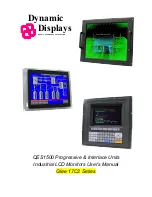
|
9
Installation and Operating Instructions
6 OPTIMISING PERFORMANCE
6.1 FUSING
6.2 CABLING
The protection equipment must be earthed and installed in
accordance with all relevant national electrical and safety
standards. The term "point of entry " protection, is a general
descriptive concept of zonal boundary protection, as detailed
in standards such as IEC 62305. Some local wiring regulations
may allow the protection equipment to be mounted directly
at the point of entry, while other countries require protection
equipment to be installed after the metering or main circuit
isolators or over-current protection.
The following installation points require attention to ensure that
optimal protection is provided by the protection equipment. This
information is provided as a guide only. Compliance with local
electrical and safety regulations must be ensured.
Over-current and short-circuit protection must be provided
in order to protect the SRF and associated wiring if a fault
develops. The over-current protection should be installed in such
a manner as to provide a means of isolating the SRF from the
mains supply. This is an important safety consideration.
The SRF N-Series SRFs do not incorporate overcurrent
protection. Upstream fusing or circuit breakers MUST be
installed. The amperage of this upstream overcurrent protection
must not exceed the load current rating of the SRF. For example,
the SRF25ON filter should be installed with upstream protection
rated at less than or equal to 250A. The load current rating of
the filter is noted on the Ratings Label on the inside of the SRF
enclosure door (and duplicated on the external side surface of
the enclosure).
The cabling and earth wires connected to the filter input should
always be run separately, with a minimum clearance of 300mm
between them and all other cables or sensitive equipment
(as shown in Figure 8 ). The input cable and earth wire will carry
the transient energy, while the protected output cable can be
considered to be a "clean filtered " supply.
By separating these cables, any incoming transients will not be
induced from the input cables onto nearby clean cables. This
clearance will reduce the possibility of arc-over from input to
output cables. Where cables need to run closer together due
to space restrictions, input and output cables should cross at
right angles and not be installed parallel to each other. Cabling
should be sized in accordance with all relevant wiring standards
to ensure that the full load current can be safely supplied. All
cabling or busbars connected to the protection equipment
should be securely anchored to prevent undue stress being
applied to input/output terminals.
Input and output terminal requirements are detailed in Table 2.
The input and output earth connections connect together on
the backplane earthing stud. This earthing stud provides the
function of connecting these earths together for continuity, and
also the functional electrical earthing of the SRF, together with
the safety earthing of the SRF enclosure. The 250A to 800A
SRFs have cable tie holes in the backplane to allow the incoming
and outgoing earth cables to be secured to the backplane
(see Figure 9).
• Cable glands (of an appropriate design) must be used for all
input and output cables to preserve the IP rating of the 63A to
250A SRFs.
• To protect input and output cabling insulation from sharp
edges around the cable entry holes suitable cable glands or
grommets must be installed.






































